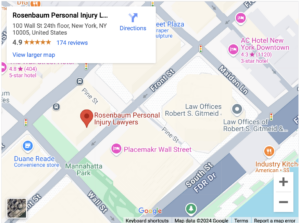Glossary of Personal Injury Terms

After you get injured in an accident, you get thrown into the world of liability insurers and personal injury claims. You will get buried in medical, financial, and legal terms you might have never encountered.
You must understand these terms to make informed decisions about the course of your claim. An experienced New York personal injury attorney can explain these terms and how they apply to your case.
Table of Contents
Catastrophic Injury
Doctors and insurers might consider an injury catastrophic for a few reasons, including:
- The permanence of the injury
- The systems affected by the injury
- The cost of treatment for the injury
You can pursue the same kinds of injury compensation for catastrophic and non-catastrophic injuries.
Causation
Causation has two meanings to lawyers. First, causation means there was a factual link between the breach and the injury.
Second, causation means the breach was the type of action that could foreseeably injure someone. This concept, called proximate cause, does not require the other party to foresee your exact injuries or how you got them. Instead, it just means a reasonable person in the other party’s position would have foreseen that someone could get injured.
Damages
Damages encompass the losses caused by the other party’s wrongful actions. They include economic and non-economic damages.
Economic damages include the financial costs of your injury, including:
- Medical expenses
- Lost wages
- Diminished earning capacity due to disabilities
Non-economic losses cover the diminishment in your quality of life due to your injuries.
Non-economic damages include:
- Pain
- Suffering
- Disability
- Disfigurement
- Dismemberment
You prove your economic damages using financial records like medical bills, receipts, and credit card statements. You prove your non-economic damages with testimony explaining how your injuries affected you.
Fatal Injury
A fatal injury causes death. This definition might seem straightforward, but doctors must look at many factors when determining the cause of death.
Some elements that might affect whether an injury gets classified as a cause of death include:
- The time between the injury and the death
- Whether the death resulted from the same system or body part as the one injured
- Whether the victim appeared to recover from the injury before the death occurred
This analysis is important because victims and their family members have different rights and damages in personal injury cases and wrongful death cases.
Incapacitating Injury
EMTs classify injuries as incapacitating when the accident victim cannot function normally. The most obvious consequence of incapacity is that you require assistance to get medical help. For example, suppose that you suffer an injury in a car accident. This injury is classified as incapacitating if you cannot drive to the emergency room and require an ambulance to take you.
Liability
Liability is the legal obligation owed by one party to another. Liabilities usually fall into two categories. Criminal liabilities arise when someone breaks criminal statutes. Personal injury cases are not criminal cases.
Civil liabilities arise when someone violates the duties they owe to someone else. Injury cases involve civil liabilities that result in physical or mental harm to the victim.
To establish liability in an injury case, you have three possible theories:
- Strict liability applies to certain activities like manufacturing consumer products
- Intentional torts happen when someone intends to make harmful contact with the victim
- Negligent torts occur when someone fails to exercise reasonable care
Negligence law underlies most injury claims, including car accidents, medical malpractice, and slip and fall accidents. Strict liability applies to product liability.
Liability Insurance
Liability insurance is a contract between a policyholder and an insurer. If the policyholder incurs a liability within the scope of the contract, the insurer pays it.
Injury claims can lead to claims under many forms of liability insurance, including:
- Homeowners
- General business liability
- Auto liability
- Professional malpractice
Your claim gets assigned to a claims adjuster who investigates it on behalf of the insurer. Your attorney will fight to settle your claim with the insurer. If the insurer refuses to settle, you may need to file a lawsuit.
Negligence
Negligence requires proof of four elements:
- Duty of care
- Breach of duty
- Damages
- Causation
The duty of care arises from the relationship between the victim and the person or business that harmed them. Thus, drivers owe a duty of care to other motorists, pedestrians, and cyclists. Doctors owe a duty to patients, and shop owners owe a duty to customers.
A breach of duty happens when the party who owes the duty performs an act or omission that exposes the other person to an unreasonable risk of harm. For example, a driver who runs a red light has breached the duty of care.
No-Fault Insurance
New York requires vehicle owners to buy no-fault automobile insurance. This insurance pays for injuries suffered by the occupants of the insured vehicle. Thus, after a crash in New York, you usually start with a claim with your insurer under your no-fault policy.
Permanent Disability
Doctors can often determine the medical probability that you will recover physical or mental functions after an injury. Permanent disabilities happen when doctors believe with reasonable certainty that you will not recover from an impairment of a body part, system, or function.
Serious Injury
Under New York’s no-fault system, you cannot sue the at-fault party unless your losses exceed your no-fault policy limits or you suffer a serious injury, such as:
- A fatal injury
- Dismemberment
- Significant disfigurement
- A fracture
- The loss of a fetus
- Permanent loss of use of an organ, body part, function, or system
- Permanent limitation in the use of an organ or body part
- Significant limitation of a body function or system
- A non-permanent injury that disables you for 90 out of the 180 days after the injury
You can file a claim against the at-fault driver’s liability insurance policy when you have a serious injury.
Wrongful Death
Wrongful death claims arise when a person dies due to someone else’s actions. The deceased person’s executor or administrator must prove the other party bears liability for the fatal injury. Wrongful death claims can arise under strict liability or due to a negligent or intentional tort.
Learn More About Your Case from a New York Personal Injury Lawyer
Injury claims require skill and legal knowledge. Contact us at Rosenbaum Personal Injury Lawyers for a free consultation to learn about your rights and how we can help you.



